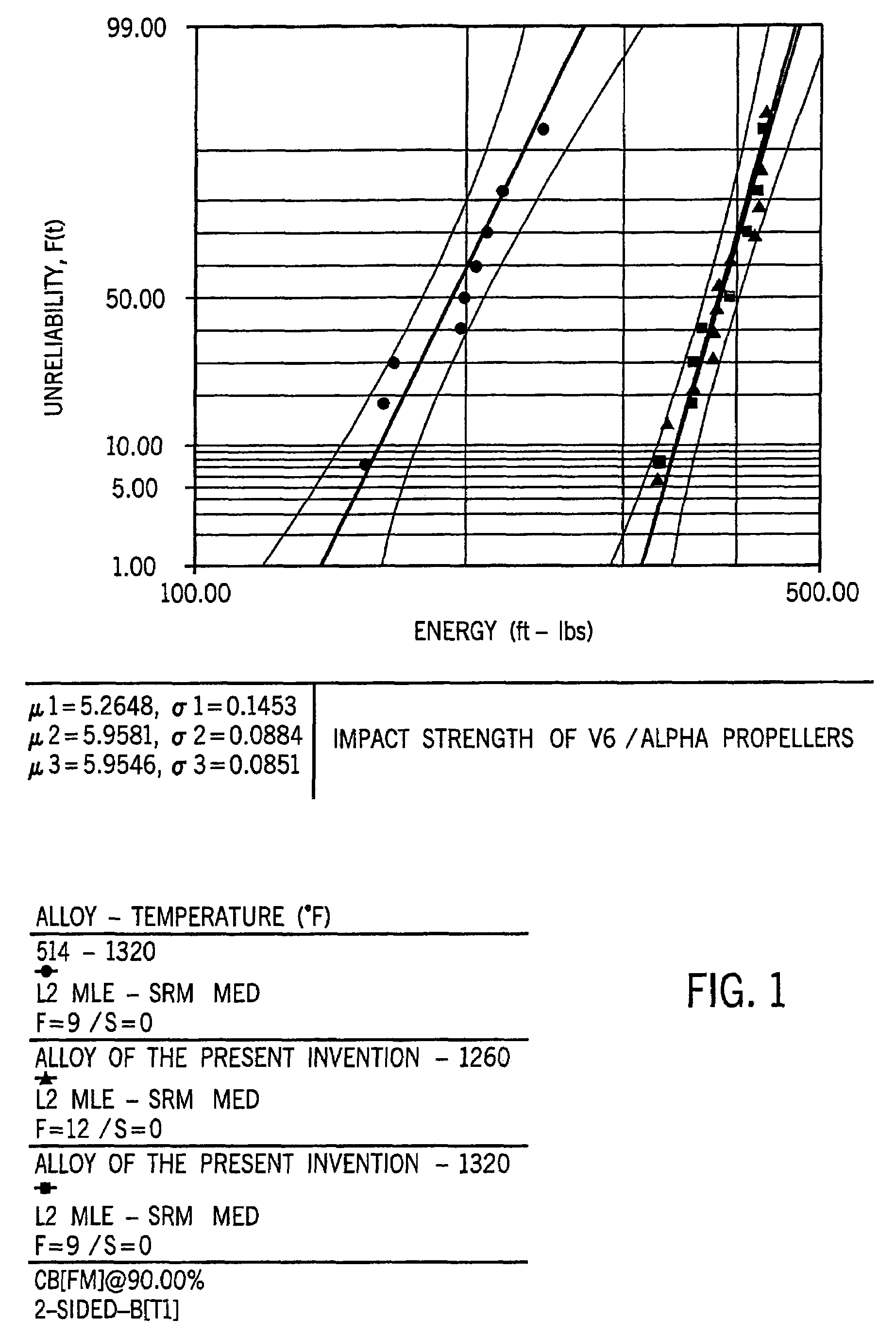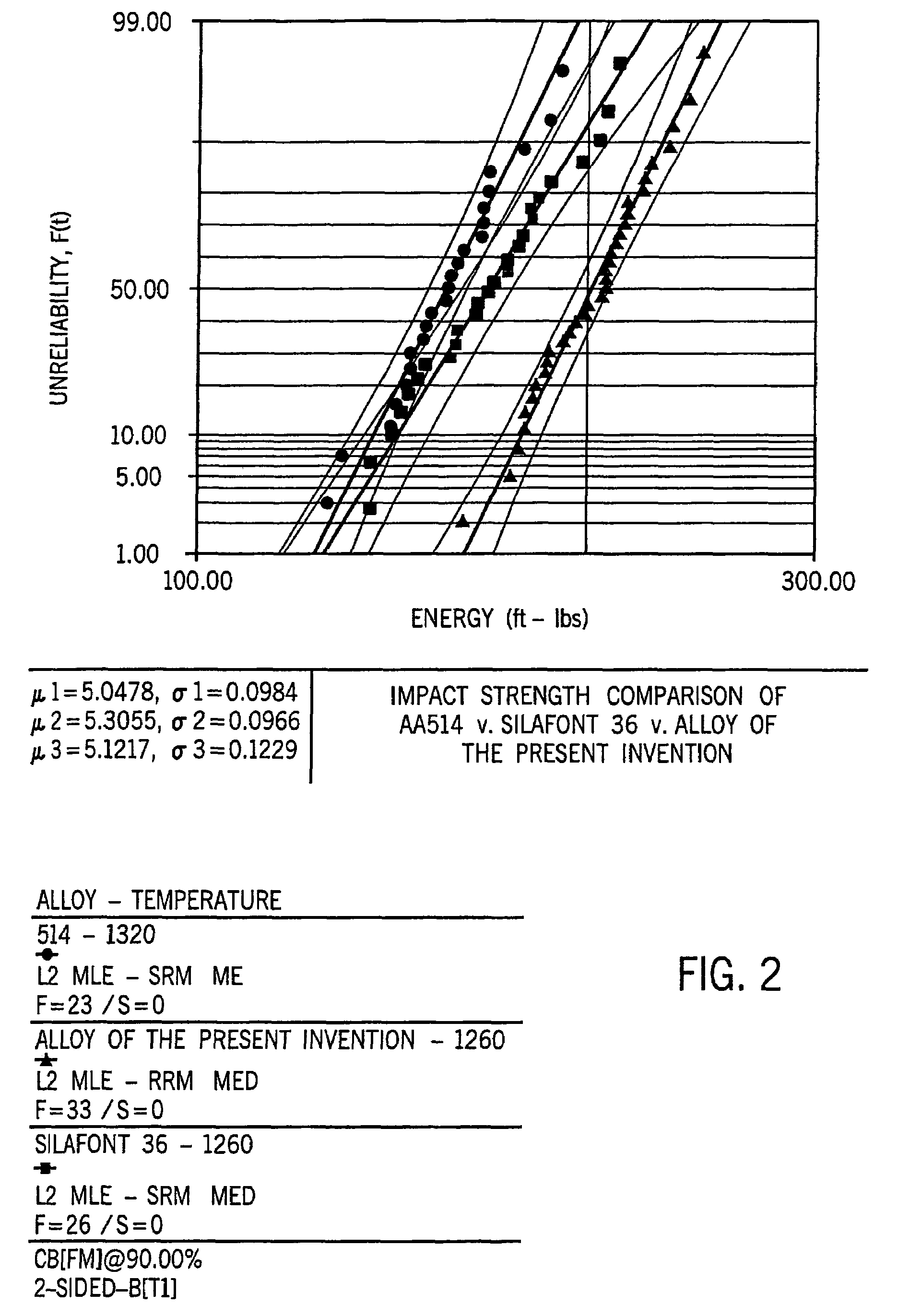Aluminum-silicon alloy having reduced microporosity and method for casting the same
a technology of aluminum-silicon alloy and microporosity, which is applied in the field of aluminum-silicon alloy having reduced microporosity and casting method, can solve the problems of reducing the ductility of the alloy, restricting the flow of eutectic liquid, and difficult to obtain a fine cast microstructure, etc., and achieves high ductility, low cost, and high strength.
- Summary
- Abstract
- Description
- Claims
- Application Information
AI Technical Summary
Benefits of technology
Problems solved by technology
Method used
Image
Examples
example 1
[0106]An alloy was prepared having the following composition in weight percent: 11.1% silicon, 0.61% magnesium, 0.85% iron, 0.09% copper, 0.22% manganese, 0.16% titanium, 0.055% strontium and the balance aluminum. Thirty-six four-cylinder die cast engine blocks were then produced from this alloy.
[0107]A control lot was prepared using an alloy having the following composition in weight percentage: 11.1% silicon, 0.61% magnesium, 0.85% iron, 0.09% copper, 0.22% manganese, 0.16% titanium and the balance aluminum. Significantly, no strontium was added to this alloy. Thirty-eight four-cylinder blocks were die cast under identical conditions as the blocks of the first alloy using a 1200 ton die casting machine. The only difference between the two sets of blocks is that the first set contained 0.055% by weight strontium and the control lot contained no strontium.
[0108]The control lot and the strontium-containing lot were machined and all machined surfaces, threaded holes and dowel pin hole...
example 2
[0112]An alloy was preparing having the following composition in weight percent: 10.9% silicon, 0.63% magnesium, 0.87% iron, 0.08% copper, 0.24% manganese, 0.14% titanium, 0.060% strontium, and the balance aluminum. Forty 2.5 L V-6, two stroke engine blocks were prepared from this alloy.
[0113]A control lot was prepared using an alloy having the following composition in weight percentage: 10.9% silicon, 0.63% magnesium, 0.87% iron, 0.08% copper, 0.24% manganese. 0.14% titanium and the balance aluminum. Significantly, no strontium was added to this alloy. Thirty-three 2.5 L V-6, two stroke engine blocks were prepared from this alloy.
[0114]Both lots were die cast under identical conditions using a 2500 ton die casting machine, at the same time, and were sequentially numbered. The only difference between the two lots is that the first lot contained 0.060% by weight strontium while the control lot contained no strontium. Both lots were machined together.
[0115]The head decks of the engine...
example 3
[0118]An alloy was prepared having the following composition in weight %:11.3% silicon, 0.63% magnesium, 0.81% iron, 0.10% copper, 0.25% manganese, 0.11% titanium, 0.064% strontium, and the balance aluminum. Thirty-seven 2 L, 4 stroke engine blocks were prepared from this alloy.
[0119]A control lot was prepared using an alloy having the following composition in weight percentage: 11.3% silicon, 0.63% magnesium, 0.81% iron, 0.10% copper, 0.25% manganese, 0.11% titanium, and the balance aluminum. Significantly, no strontium was added to this alloy. Twenty-five 2 L, 4 stroke engine blocks were prepared from this alloy.
[0120]Both lots were die cast under identical conditions using a different die casting machine than the first two examples. The lots were cast at the same time, and were sequentially numbered. The only difference between the two lots is that the first lot contained 0.064% by weight strontium, while the control lot contained no strontium.
[0121]The head decks of the engine b...
PUM
| Property | Measurement | Unit |
|---|---|---|
| tensile strength | aaaaa | aaaaa |
| tensile strength | aaaaa | aaaaa |
| tensile strength | aaaaa | aaaaa |
Abstract
Description
Claims
Application Information
 Login to View More
Login to View More - R&D
- Intellectual Property
- Life Sciences
- Materials
- Tech Scout
- Unparalleled Data Quality
- Higher Quality Content
- 60% Fewer Hallucinations
Browse by: Latest US Patents, China's latest patents, Technical Efficacy Thesaurus, Application Domain, Technology Topic, Popular Technical Reports.
© 2025 PatSnap. All rights reserved.Legal|Privacy policy|Modern Slavery Act Transparency Statement|Sitemap|About US| Contact US: help@patsnap.com



